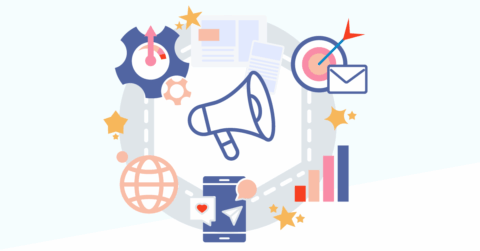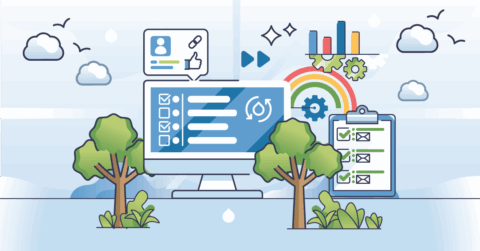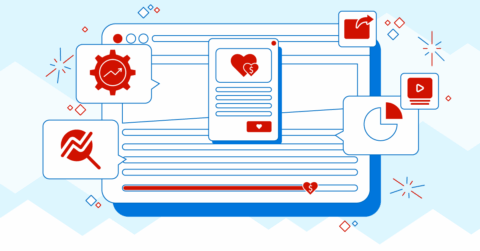
Lúgh Studio’s Ultimate Guide To Lead Generation For Nonprofits
01/26/23
donations
Today we are sharing our ultimate guide to lead generation for nonprofit.
Lead generation is essential for businesses, but just as important for nonprofits. Today we talk about the difference between the two, the benefits of effective lead generation for nonprofits, and our main tips for the process.
Download Your PDF Version of this Guide Here
…

What Is Lead Generation?
At its most basic, lead generation for nonprofits is the process of identifying and cultivating potential donors or supporters. It is an essential component of any nonprofit’s fundraising and growth strategy, and it helps to build a sustainable base of support for the organization’s mission and programs.
Lead Generation For Business Vs. Nonprofit: What’s The Difference?
Lead generation for non-profit organizations and lead generation for private businesses have some similarities, of course. Still, there are also some key differences.
Some of these include:

Different goals
The main goal of lead generation for private businesses is typically to generate revenue by converting leads into customers. On the other hand, the main goal of lead generation for non-profit organizations is almost always to generate funding by converting leads into donors.
Different target audiences
Private businesses most usually target leads who are interested in purchasing their products or services – either immediately or some point in the future. Meanwhile, non-profit organizations approach leads interested in supporting their mission and programs.
Different lead generation strategies
Private businesses may use strategies such as paid advertising, email marketing, and search engine optimization (SEO) to generate leads. In contrast, non-profit organizations often implement things like networking, direct mail, and community outreach.

Different conversion metrics
Private businesses measure the effectiveness of their lead generation efforts by tracking the conversion rate of leads to customers. On the other hand, non-profit organizations track the conversion rate of leads to donors.
Different return on investment
The return on investment for private businesses may be measured in terms of revenue generated from sales. For nonprofits? The ROI is usually measured in terms of funding generated from donations.
Different messaging
Private businesses will usually stick with messaging that focuses on the benefits of their products or services. Meanwhile, nonprofit organizations focus on the impact of their mission and programs.
Why Lead Generation For Nonprofits Is So Important
Lead generation can have a number of positive effects for a nonprofit organization. Here are just a few of them:
- Increased funding: One of the most obvious benefits of lead generation is that it can help to increase the funding available to the organization. By identifying and speaking with potential donors and supporters, nonprofits can build a sustainable base of support for their mission. This helps to ensure the long-term financial stability of the organization.
- Greater awareness and engagement: Lead generation can also help to increase awareness and engagement around the nonprofit’s mission and programs. Want more people to know about the work your organization is doing? Lead generation is your answer! By reaching out to potential donors and supporters, nonprofits raise awareness of the organization and inspire others to take action and get involved.
- Improved donor retention: Effective lead generation also increases how long donors stay donors. Because many lead generation tactics are focused on building relationships, nonprofits can create a sense of loyalty and commitment. This increases the odds of continued donor support into the future.
- Higher efficiency: Lead generation can also help to improve the efficiency of the nonprofit’s fundraising efforts. By identifying and targeting potential donors who are most likely to support the organization, these organizations can focus their efforts on the groups of people who are most likely to make a donation. This helps to maximize the return on investment for their fundraising efforts.
- Greater community impact: By building a sustainable base of support for their mission and programs, nonprofits expand their reach and the total impact that they can have. This creates a virtuous cycle, as heightened awareness through lead generation leads to more donations, which results in a higher impact overall.
Negative Consequences Of No Plan

Likewise, nonprofits that don’t take lead generation seriously enough often experience a number of negative effects. These include, but are not limited to:
- Lack of funding: This is perhaps the most obvious negative consequence of not taking lead generation seriously. Without a steady stream of donations, nonprofits struggle to pay for the programs and services they provide. This, of course, leads directly to a reduction in the impact they are able to have in the communities they serve.
- Not as much awareness: Without a strong base of support, nonprofits can struggle to raise awareness of the issues they are working on. This creates a general downward trend of the things the organization is able to achieve.
- Poor donor retention: Poor lead generation for a nonprofit can also lead to poor donor retention. Without strong relationships with donors and supporters, keeping donors interested in the cause and engaged with their contributions can be an uphill battle over the long term.
With so many benefits of a good lead generation plan (and a host of issues that can arise), lead generation is one of the areas nonprofit organizations do well to focus on.
But where do you start? Now that we’ve laid the foundation of the importance of a good lead generation plan, let’s dive into specific advice. Remember – these are just tips. You know your organization better than anybody else, and only you know what has the chance to actually work.
Still – no harm in experimenting!
Tips For Effective Lead Generation For Nonprofits
There are many different ways to generate leads for a non-profit organization, and the best approach will depend on the specific goals and resources of the organization. Here are some of the most common you might consider:
1) Networking
Building relationships with other organizations and individuals in the non-profit sector can be a great way to generate leads. This can be done through attending conferences and events, joining professional associations, and connecting with other non-profit leaders on social media.

2) Direct mail
Sending targeted mailings to potential donors or supporters can also be a great idea. This can be done by purchasing mailing lists or by using data from past donors to create a targeted mailing list. Of course, this is only viable if you have the budget for it and implement decent copywriting.
3) Online marketing
A huge topic in general, “online marketing” is an umbrella term that can include everything from social media and email marketing to search engine optimization (SEO). Depending on your own organization, these can all be great ways to generate leads. Be sure to check out our guide to content marketing, email marketing, and paid advertising if you are considering any of these methods.

4) Volunteer recruitment
Recruiting volunteers to help with fundraising and other activities can also be a great way to generate leads. How you go about it? While it can take various forms, volunteer recruitment is usually done by reaching out to current volunteers and asking them to refer friends and family. This can be tricky, because you need to make sure your volunteers are trained correctly, but it’s still a tactic you might consider.
5) Community outreach
This method of lead generation is all about building relationships with members of your community. This can be done by attending community events, participating in local activities and initiatives, and working with other organizations to promote the nonprofit’s mission and programs.
General Advice For Lead Generation For Nonprofits
One of the most important things to keep in mind when generating leads for a non-profit organization is that your leads are actually high-quality. They also need to be relevant to the organization’s mission and programs.
This can be done by targeting specific groups of people. For example, these could be individuals who have shown an interest in similar causes or organizations, or by using data from past donors to create a targeted list of potential supporters.
A big part of this is the relationships you build with donors. Be sure to maintain good communication with donors and supporters throughout the lead generation process. This can be done by keeping them informed about the organization’s activities and progress, and by providing opportunities for them to get involved and take action.
Another important factor to consider is the cost of lead generation. Some lead generation strategies, such as direct mail and paid advertising, can be quite expensive. This makes it essential to carefully evaluate the potential return on investment before committing to a particular strategy.
To maximize the effectiveness of lead generation efforts, you need to have a clear and compelling message that resonates with potential donors and supporters. This can be done by clearly communicating the impact of the organization’s programs and mission. You can also make it a point to highlight the specific ways that donors can make a difference.
Finally, as in all marketing efforts, you need to be willing to make adjustments as needed. This can be done by tracking the number of leads generated, the conversion rate of leads to donors, and the overall return on investment. Not all tactics are going to pay off, and an attitude that makes room for experimentation is one that will bring you more success.
Recommended Resources

Here are some recommended resources for non-profit organizations looking to improve their lead generation efforts:
- Our Ultimate Guide to Nonprofit Marketing: Looking for a crash course in how to approach marketing at your organization? This is it!
- The Nonprofit Marketing Guide: This website offers a wide range of resources, including articles, e-books, and webinars, on topics such as fundraising, marketing, and communications for non-profit organizations.
- Network for Good: This resource includes a range of tools and resources for non-profit organizations, including a donor management system, a fundraising platform, and a library of articles and e-books on fundraising and marketing.
- Charity Navigator: A quality website that provides ratings and reviews of non-profit organizations, as well as a library of resources on topics such as fundraising, governance, and accountability.
- The Nonprofit Times: A collection of news and information on the nonprofit sector, as well as a library of articles on topics such as fundraising, marketing, and governance.
- The Fundraising Authority: A wide range of resources and tools for non-profit organizations, including articles, e-books, and webinars on fundraising and donor development.
Conclusion
Overall, lead generation is a critical component of any non-profit organization’s fundraising and growth strategy. By utilizing the resources and strategies discussed here, non-profit organizations can improve their lead generation efforts and build a sustainable base of support for their mission and programs.
With the right approach, nonprofits can increase funding, awareness, donor retention, efficiency, community impact, and accountability, which can lead to a greater impact in the communities they serve.
Good luck in your efforts! Reach out to us if you ever need any help getting results!
Download Your PDF Version of this Guide Here
…
Are you an enterprise, nonprofit or small business looking for help on your website? Give us a shout! We provide a free consultation. Email us at [email protected] or call us at (718) 855-1919!









